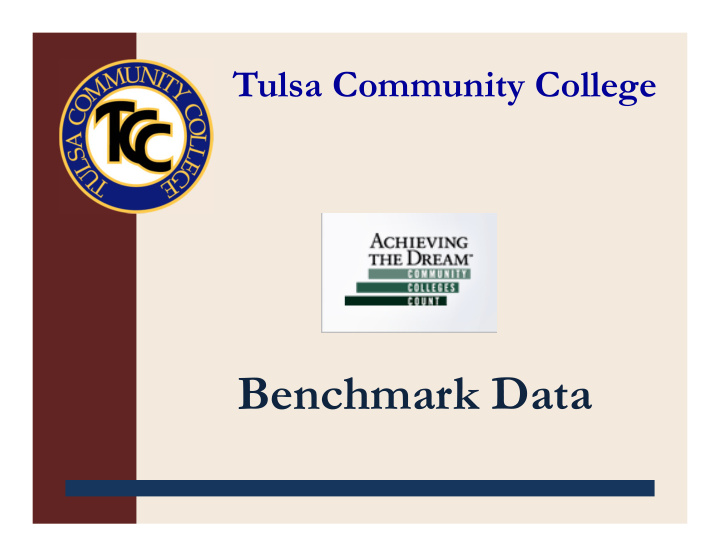



Tulsa Community College Benchmark Data
Table of Contents • Student Cohort Profile • Goal 1: Developmental courses • Goal 2: Gatekeeper courses • Goal 3: Complete courses successfully • Goal 4: Re-enrollment (persistence) • Goal 5: Completions
TCC Cohort Profile Fall 2004 Cohort 1,972 First-time to TCC Students *includes students who withdrew after final add/drop date (All statistically significant differences are calculated at the 95% confidence level or higher.)
Gender
Age
Campus of Primary Attendance
Ethnicity
Enrollment Status 47% of cohort took 12 credit hours during entry semester.
Degree Type *at entry semester
Financial Aid $1700 average during entry semester.
Academic Preparation • 60% reported ACT scores; average ACT composite score = 19.6 • 77% were tested for remedial needs • 18% enrolled in developmental English/writing • 29% enrolled in developmental reading • 67% enrolled in developmental math
Successfully complete developmental courses and progress to credit-bearing courses (success = “C” or better)
Developmental Placement (based on entry-level assessment) 40% 30% 17% 13% 591 788 329 263
Writing Placement (based on entry-level assessment) 83% 11% 6% 218
Reading Placement (based on entry-level assessment) 71% 13% 16% 1404 263 305
Math Placement (based on entry-level assessment) 58% 33% 7% 2% 648 48 143 1133
Where are our students succeeding?
Success Rate with a “C” or Better (based on number of attempts) Intermediate Algebra……………. 45% Beginning Algebra………………. 49% Basic Math ..……………………… 63% Writing II ..………………………… 61% Writing I…………………………… 65% Reading II…………………………. 64% Reading I …………………………. 64%
Who is succeeding with a “C” or better?
Developmental Course Success by Gender
Intermediate Algebra Success (based on number of attempts) 248
Beginning Algebra Success (based on number of attempts) 196 375
Basic Math Success (based on number of attempts) 210 445
Writing II Success (based on number of attempts) 87 130
Writing I Success (based on number of attempts) 79 111
Reading II Success (based on number of attempts) 202
Reading I Success (based on number of attempts) 91 164
Developmental Course Success by Ethnicity
Basic Math Success (based on number of attempts) 80 10 100 430 22 44
How many students persisted from developmental coursework into College Algebra or Freshman Comp?
Persist to College Level?
Developmental Course Summary • Females were significantly more successful in all developmental course work • African Americans who enrolled in Basic Math faced significantly greater challenge • No significant differences by age, degree type, or enrollment status • Most students who required remediation did not persist to College Algebra • Over half of students requiring writing remediation did persist to Freshman Comp I
Enroll in and Successfully complete gatekeeper courses (success = “C” or better)
Gatekeeper Course Success 93 175 368 1189 272
Gatekeeper Course Success 1823 1251 974 1345 394
What differences exist based on gender, ethnicity, age, enrollment status, or degree type?
Freshman Composition by Gender 757 1066 473 778
Intro to Psychology by Ethnicity 144 28 101 842 43 31
Freshman Comp II by Age 990 117 68 51 25
American Federal Government by Age 1038 138 80 62 27
Psychology by Enrollment Status Psychology by Enrollment Status 899 290
College Algebra by Degree Type 49 133 302
Gatekeeper Course Summary • 10 Gatekeeper courses were identified based on enrollment frequency and/or success rate • Female students were more successful in Freshman Comp I and II • African Americans, and more specifically African American males were most at risk
Complete the courses taken with a grade of “C” or higher
Percent C or Higher by Gender 2649 4499
Percent C or Better by Ethnicity 802 204 595 5103 266 176
Percent C or Better by Age 5213 766 482 459 228
Grade Summary • Females significantly more successful • African Americans are less likely to attain a “C” or higher • Among non-traditional student, success increases as age increases • No difference was found between full-time and part-time students • UT students had a higher cumulative GPA (2.43) than WD students (2.26)
Re-enroll from one semester to the next
717 Persist or Graduate 781 968 989 1485 1972
Persist or Graduate by Gender 100% 100 Male (N=800) Persistence Rate 78% 71% Female (N=1172) 80 53% 52% 60 46% 45% 42% 39% 36% 33% 40 20 0
Persist or Graduate by Ethnicity *The one Native Hawaiian was removed from the dataset
Persist or Graduate by Minority Ethnicity Native American (N=222) Asian (N=46) 100 African American (N=201) Persistence Rate Hispanic (N=74) 80 60 40 20 0
Persist or Graduate by Degree Type University Transfer (N=649) Workforce Development (N=268) 100 Undeclared (N=103) Persistence Rate Degree Code Missing (N=952) 80 60 40 20 0
Summary of Persistence • Females were significantly more likely to persist • African Americans were less likely to persist from Fall to Fall and from entry semester to last Spring semester • African American males were at highest risk for drop out • Students 21-24 years and 30-39 years were most likely to persist • Students with unidentified majors do not persist
Degree or Certificate Completion (within 3 years)
Total Completions over 3 years 222 Completions by 212 Students
Did they Graduate?
Graduation Rate by Number of Developmental Areas Required 591 789 329 263
Graduation Rate By Writing Placement 1628 126 218
Graduation Rate by Reading Placement 1404 263 305
Graduation Rate By Math Placement 648 48 143 1133
Summary of Completions • 212 students earned 222 degrees and certificates, yielding an 11% graduation rate (within 3 years) • University Transfer majors had a higher completion rate than Workforce Development students • Students needing more than one area of developmental coursework are less likely to graduate
What do we do with Next Steps: these data?
Next Steps • Today: Identify and prioritize challenges to student success based on these data • November: Begin to identify barriers to success related to these challenges • Spring: Begin to develop interventions around these challenges
Not everything that counts can be counted, and not everything that can be counted counts. Albert Einstein
Recommend
More recommend